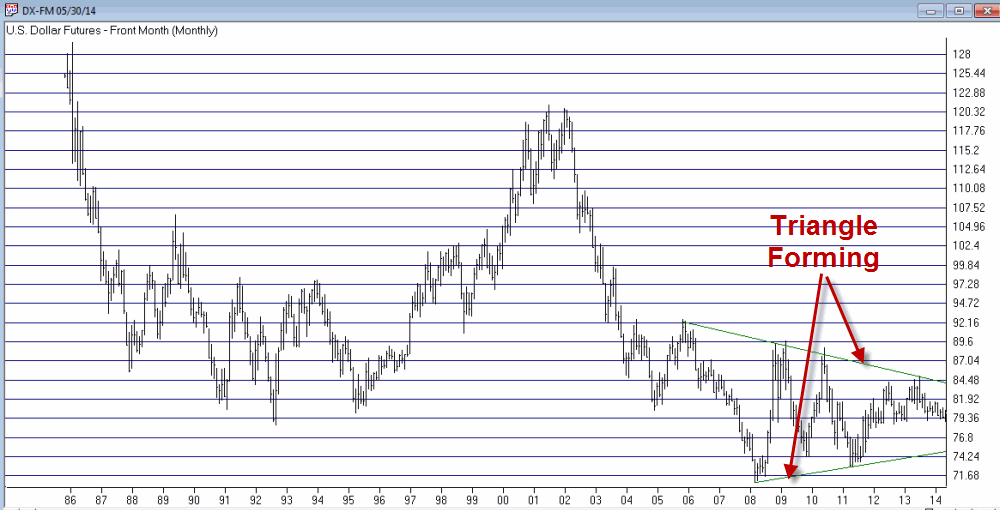Well, OK, maybe not. But life here in the Good Old US of A may be affected profoundly. Which of course, would ripple out and affect much of the rest of the world. So maybe it’s not that outrageous.
In any event, it sure is a catchy title, no? In truth this piece is not an immediate call to action, but rather one of those short “hey, you might want to keep your eye on this” type pieces. I am writing about the U.S. Dollar.
There are pro’s and con’s to a strong U.S. Dollar and there are pro’s and con’s to a weak U.S. Dollar. If you would like to know what they are please see the steps below:
Step 1) Go to your web browser. Type www.google.com and press Enter
Step 2) Type “pros and cons of strong U.S. dollar” and press Enter.
Step 3) Browse among the approximately 308,000 or so links until you find your answer.
Step 4) Type “pros and cons of weak U.S. dollar” and press Enter.
Step 5) Repeat Step 3.
Since at least the end of the gold standard in 1971 the U.S. dollar has served as the world’s “reserve currency”. (This basically means that if you could only hold one currency you would want to hold the dollar.) This has become one of those things that most people take for granted and assume will go on forever.
Still, given that we are now the most indebted “We the People” in the history of the planet, perhaps we shouldn’t be surprised that there has been a lot of talk recently (granted mostly among intentionally frightening and mostly annoying infomercials) about how the days of enjoying “reserve currency” status are numbered, and how this will trigger a panic out of the dollar, which will lead to all kind of bad things like, well, see Step 4 above.
Will the Dollar Collapse?
For me to pretend that I have the slightest idea whether or not the U.S. dollar will someday collapse would be a joke, and not the funny kind. But as a trader and investor my “thing” is not so much “what will happen” as it is “what could happen and what the heck do I plan to do about it if it does?”
Which leads me to the following distractions:
Jay’s Trading Maxim #235: It’s not so much how much you make when things go right, but how much you keep when thing goes wrong.
Jay’s Trading Maxim #236: If you take care of the losing trades, the winning trades will take care of themselves (OK, for the record, this is not mine, I just gave it number 236 so I could use it as a segue into…..)
Jay’s Trading Maxim #237: Successful traders worry less about “Kicked Ass” and more about “Ass Kicked”, if you get my drift.
So why am I bringing all of this up? Take a look at Figure 1 which displays a monthly chart of continuous U.S. dollar futures. While the history of U.S. dollar trends is all very interesting and I would love to recap it for you, I am going to opt for the “a picture is worth a thousand (likely incredibly boring) words” mantra and encourage you simply to glance at Figure 1 if you want to know where the dollar has been in the past.
And when you do – here is the important part – note that the dollar is forming a narrowing triangle (is there another kind?) pattern. In other words, starting with the high in 2006 the dollar has been fluctuating in an ever smaller range.
We “market analyst types” refer to this as “coiling” action. Now if you are like me chances are you just squirmed slightly when you read that last sentence. Because we all know what happens when something stops coiling – that’s right, it “uncoils”. And “uncoiling” is typically not a quiet affair.
So here is the bottom line. At some point – and just for the record it might not be for several years – the U.S. dollar will break out of this triangle one way or the other. And chances are it will move sharply in price from that point. And whether it breaks out to the upside or the downside it will have significant implications for the quality of life here in the U.S. If you don’t believe me, see the 308,000 links referenced in Step #3 above.
So make a note to check in on the dollar once in awhile. Because one of these days something profoundly significant is going to happen.
Jay Kaeppel
Chief Market Analyst at JayOnTheMarkets.com and AIQ TradingExpert Pro (http://www.aiq.com) client


